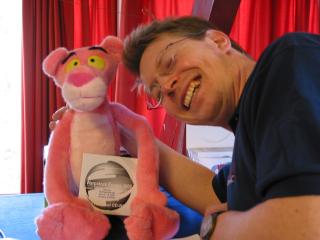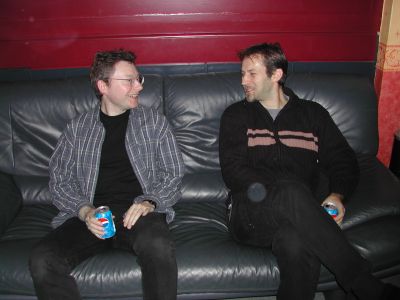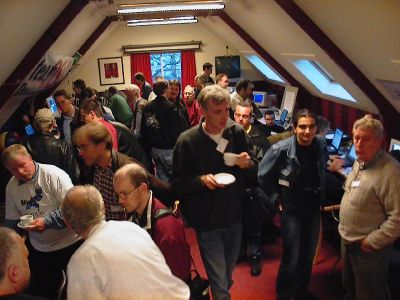
VOICE Home Page: http://www.os2voice.org
[Newsletter Index]
[Previous Page] [Next Page]
[Feature Index]

VOICE Home Page: http://www.os2voice.org |
December 2002
[Newsletter Index]
|
An editorial view from Christian Hennecke.
Another Warpstock Europe is over, and for the second time VOICE exhibited at both Warpstock events, in North America and Europe. As last year, we offered CDs with the Newsletter archive, but this time the rest of the CD was filled with numerous shareware and freeware applications and tools and VOICE members got a discount. We learned from the experience of last year and didn't offer printed issues for sale this time. Instead we had two issues printed in color on high-quality paper which visitors could read at the booth. Of course, they could also join VOICE or renew their membership.
As it turned out we were able to profit from including software with the CD and sell some more than last year. I am also quite fond of the fact that more people renewed their membership and that we got a new member (Welcome aboard, Howard!). Other members of VOICE dropped by and said "Hello", one of whom was a guy who works in a hospital in Saudi Arabia. The "I" is for "International"... Thomas Klein interviewed some people including Bart van Leeuwen and Markus Montkowski for the Newsletter. So you can expect some interesting reading soon. We also joined Team OS/2 Germany in their daily raffle and tossed in three licenses of the Contact/2 address manager, which the author Frank Wochatz had donated.
As last year, I didn't get to see many presentations, since we had to man the booth. In fact, things were worse this year, because one person couldn't attend and we were only two people. My sincere thanks to Thomas Klein without whom there wouldn't have been a VOICE booth at all. If you are interested in the presentations, have a look at Menno Willemse's report. In the following, I'm going to focus more on what else happened and some background information.

So what's new and exciting? First of all, it's striking that there are several efforts to improve, extend, and/or replace parts of OS/2. This starts with the new Netlabs EPM Distribution, which simplifies the installation of EPM and extensions a great deal and also implements additional features. Even the first release of this project already helps a lot in unleashing a power that many wouldn't have thought EPM had. It continues with a new model for processing streaming audio and video by John Gow which is called Digital Transport Agent. From what I heard this is going to be faster, more stable, more flexible, and easier to program for than what MMPM/2 does provide now, while retaining backwards compatibility. (And it is what makes the upcoming Soundblaster 16 emulation for the DOS box possible. Good news for the ones out there who are into vintage gaming. :-) ) And it looks like the efforts don't even end with a project for a new device manager that is supposed to enable OS/2 to load USB drivers at run-time.
The new Lookout/2 application is very promising. As the name suggests, it is intended to be a kind of Outlook-clone, but better. The interface looks similar to Outlook, but supports OS/2-specifics like context menus for folders, which we know from the WPS. So far the feature list includes an e-mail client and personal information manager with support for handheld-computers like the Palm Pilot, but thanks to the modular plug-in approach, there will probably also be a news client, a fax solution and other stuff.

Judging from the presentation, WarpVision is also coming along well. They showed a number of funny videos and successfully played "The Lord of the Rings" from DVD. I've been told that they also demoed a "cool" feature to use a video as the desktop background.
At the final session on Sunday, Kim Cheung of Serenity Systems talked about the future of eComStation. Serenity has been working on remote booting OS/2 inside the virtual machine as a means of improving the performance of OS/2 as a guest operating system. Kim stated that in that role there was an opportunity to not only improve performance and reliability, but also flexibility and manageability through the use of the FIT table. The demo of this new remote booting concept didn't quite work out due to a driver problem (it did on Friday), but the parts which did work already showed a considerable increase in speed.
As far as running OS/2 the normal way is concerned, he said that according to Daniela Engert probably the only thing that could prevent eComStation from running on future hardware was ACPI, which is intended to replace the old BIOS stuff, if I understood that correctly. I tossed in a question about the threat that is imposed by the TCPA/Palladium concept, which is currently pushed in the US and causing heated debates, but Kim didn't want to follow that path.
After that, Kim showed eComStation booting very fast in some virtual machine that was running on Windows 2000. There were no details given other than that it was code-named "Warp Virtual", a research project which might provide additional news to users in 2003. Of course this sparked a number of questions, also regarding Virtual PC. Kim replied that Virtual PC was an excellent product, but that for them to apply their Managed Client technology and deliver additional value to users, they needed the ability to support the OS/2 guest operating system on operating system hosts besides Windows, or OS/2 for that matter. He further explained that for several reasons dealing with the user requirements, market directions and technologies, they were interested in extending the virtual machine to support multiple host operating systems, with FreeBSD as a prime candidate. That would enable them to stabilize the hardware which OS/2 sees. In turn, that ability added options for their long range ability to continue to support OS/2 through agreements with IBM.

This was my fourth Warpstock Europe and each one has been different as far as the kind of venue and the atmosphere are concerned. I have heard some quite mixed comments about holding Warpstock Europe in a hostel, and I do have to admit that I had some doubts beforehand. When I arrived on Thursday, Gerrit Schoenmaker - the Warpstock Europe chairman - asked what I thought about it. Well, the word that immediately came to my mind was "cozy". I felt comfortable and at ease.
A very important part of Warpstock is the social one. You get to see all those familiar faces again, you can see who is behind those names and e-mail addresses you read in Usenet, on web sites and in the "Product information" dialog of your favorite applications, and you can chat a lot with people from all over the world and exchange ideas and stories. I heard that one visitor even came from South Africa. Quite a distance, isn't it? The completely informal atmosphere, the somewhat limited space, and the fact that a good deal of the visitors stayed at the hostel all built some "good vibrations". (This was different from the year before, where the long corridors and huge lecture rooms made many people feel a bit lost and lonely.) In the evening people either joined for dinner in the hostel itself or gathered in larger groups to drive to the city of Arnhem. Afterwards you could meet many other visitors in the hostel's bar, where people were having a drink, chatting, playing pool or even compiling XWorkplace until about 1 AM. I don't think that anyone really missed a social event. So it's not exaggerated to say that this part of Warpstock Europe was a great success.
There is another important part of Warpstock: "business" in a wider sense. That is where this Warpstock Europe did not fully live up to the people's expectations. While some of the presentations could make a stay worthwhile to a business user, there were only four commercial exhibitors. ARtem, the fifth, had cancelled, which probably was related to them being bought by Funkwerk shortly beforehand. Now, please don't shoot the messenger. I don't want to criticize the organizers, in fact they did a really good job. Just think about the following: Together with the "quality", or better the "image", of the venue, the presentations, the number of commercial exhibitors determines the perception of Warpstock in both the OS/2 community and the outside world. The problem is that this indicator also works the "state of OS/2 = state of Warpstock" way. Alas, the last three years with Warpstock Europe consecutively held at a bank's center for further training, at a university and at a hostel do have been perceived as a decline of that event and OS/2 itself.
This will have to be taken into account for next year. The probing questions besides "Who is going to do it this time?" are: How do we get more commercial exhibitors to attend? Do we want more business users to attend, and how do we manage to get them to? Do we sacrifice some of the Warpstock social spirit to get them to attend, and if so, how much? Should Warpstock focus more on being a social event for end-users, an opportunity for exchange of know-how than try to appeal to everyone? I think this last question has already been answered by many end-user visitors: They won't spend the time and money just for meeting other people in the long run. To make Warpstock attractive, it has to also provide opportunities for extending the visitor's knowledge and to buy things while taking place at some nice location. This means that reaching business users is a must, with all its consequences that result from their standards. On the other hand, one has to ensure that end-users and developers still feel comfortable. Warpstock Europe 2000 in Karlsruhe even seemed a bit too businesslike to some. A tightrope walk.
So the issues which we are facing in Europe are about the same as in North America: a decline in exhibitor numbers, a decline in active community members, and so far there is no clear vision of how to work around them. Well, if you think that you do have one, then stand up and submit a bid for 2003 (see http://www.warpstock.org/about/bid_proposal.html for how to do so for Warpstock 2003). Those who make a successful bid are the ones who will have the most say in the direction which the events will take. And don't forget that without enough people who are willing to take on the task, there will be no more Warpstock events at all. If you would like to participate in the discussion about where the Warpstocks should go, join the Warpstock-public list at Yahoo. Don't be afraid to join if you are "only" a visitor. Without your opinion, nobody knows if their concept will probably be accepted or not.
Last, but not least, I would like to thank all the people who made this Warpstock Europe possible. Gerrit Schoenmaker, Bart van Leeuwen (also for getting me a room at the hostel last-minute) and all those volunteers, whose names I don't know for the most part. Especially those members of the HCC who did not belong to the OS/2, but to the Linux and Windows sections. Yes, believe it or not, these people actually donated their time for helping users of that dead operating system. When I heard this, I was pleasantly surprised. These Dutch (and Belgian?) people sure taught all OS/2, Linux, Windows or whatever die-hards, who like to look down on users of other OSes, a lesson. Again, thank you.
VOICE Newsletter Update: The planned page for free small advertisements by freeware authors and OS/2 users is going to become part of the VOICE home page soon. Its delayed as our webmaster has just relocated and isn't as yet back up to full speed yet. If you are interested, please contact us at ads@os2voice.org.
We are always interested in your thoughts and views on subjects related to OS/2, and would like to see opinion/editorial pieces as well as hardware/software reviews and HowTo articles. If you can help by writing an article please contact me at editor@os2voice.org.
Our Newsletter team is in need of backup. A few people have joined after we published a call for help in one of the last issues, but we could do with some more. To be able to help you don't have to be a very good translator or HTML programmer. If you have profound knowledge of English or German spelling and grammar, you can also help with editing the articles. Some hints on translation activities are also available in the FAQ.
Warp Doctor: Have an idea for Warp Doctor? You can send your comments directly to the Warp Doctor web guy Jeremy at rs@fyrelizard.com or better yet attend one of our Warp Doctor Team meetings, weekly on IRC.
Everyone's help is required to keep this project going. Please note the change in schedule again. The team meets every Sunday at 3PM EST (20:00 GMT) now on IRC in the #warpdoctor channel on the WEBBnet IRC network. The alternate Sunday schedule was too confusing. For more information on attending online IRC meetings please see the VOICE Meeting Information page - http://www.os2voice.org/meetinginfo.html.
VOICE Online Update: This month the general member meetings are scheduled on December 2 and 16 at 8PM EST (01:00 GMT). Everyone interested in OS/2 or eComStation is invited to attend either or both of these sessions in VOICE on the Webbnet IRC network. For more information on attending online VOICE IRC meetings please see the VOICE Meeting Information page - http://www.os2voice.org/meetinginfo.html.
If you have an idea for a Speakup event, please submit it to liaison@os2voice.org, and we will try to schedule something. As always, please be sure to check out the updated VOICE Future events Calendar in this newsletter or on the VOICE website at http://www.os2voice.org/calendar.html for more details on future VOICE events.
This month Thomas Klein returns with part four of DrDialog, or: How I learned to stop worrying and love REXX. He continues with his overview of development of REXX programs with GUI using the free development environment DrDialog by IBM. This should be interesting for anybody, especially for those who have always wanted to write their own OS/2 applications, but were afraid of the high learning curve of PM programming.
The Workplace Shell is one of the key features which make people stick to OS/2 and eComStation. While the WPS's concept is excellent, it could use some extensions. Besides XWorkplace, there is another application which has set out to do something about that lack and a new version of which has recently been released: DragText 3.7 by Rich Walsh. Doug Bisset and Christian Hennecke try to give an overview in DragText 3.7 - What is it and what can it do?.
Lots of other people visited Warpstock Europe, and each one has his/her own view, of course. Menno Willemse attended a larger number of presentations and, as last year, fills you in about his own experiences at Warpstock Europe 2002.
Mozilla has come a long way and many features have been added and improved. But every now and then, there may still be something that you miss. Fortunately, Mozilla has been written in a way that makes it easily extensible and quite a few people have already taken advantage of that. In Multizilla - more than a tab browser addon Mark Dodel reviews this very handy extension.
Then Tom Nadeau presents you with his warped perspective of Warpstock, Austin in Warpstock 2002 review - The Innovation Continues.
Finally we have the VOICE Newsletter OS/2 Tips page and the Letters, Addenda, Errata page. If you have any OS/2 or eCS tips you've uncovered, please send them to tips@os2voice.org. If you have any comments or suggestions about the newsletter or articles in it, please send them to editor@os2voice.org.
That's it for this month. Upcoming articles include an update by Alfredo Fernández Díaz of his July 2000 article on the current state of booting OS/2 from a CD, a review of a USB memory card reader by Mark Dodel and the next articles in the series on DrDialog.
Mark Dodel, Christian Hennecke and Jason R. Stefanovich
VOICE Newsletter editors
[Feature Index]
editor@os2voice.org
[Previous Page] [Newsletter Index] [Next Page]
VOICE Home Page: http://www.os2voice.org